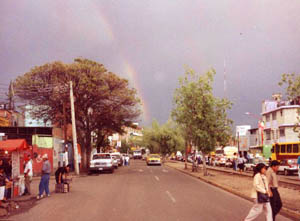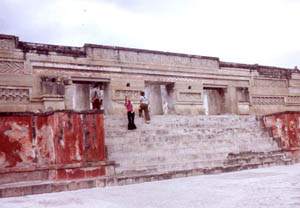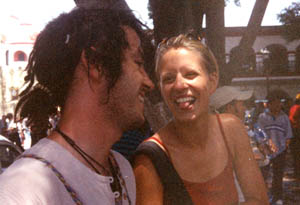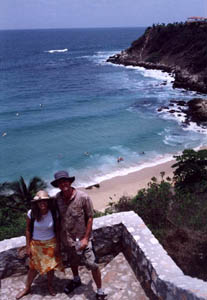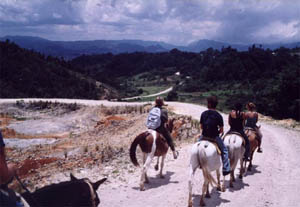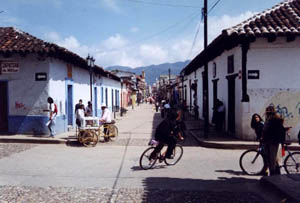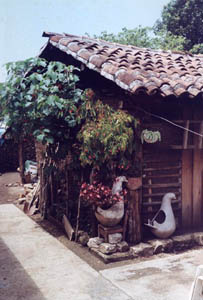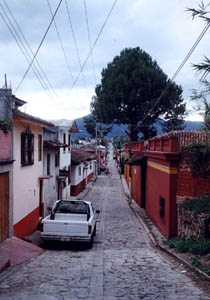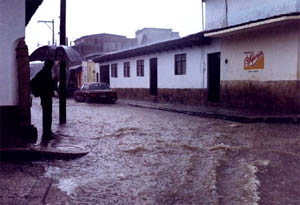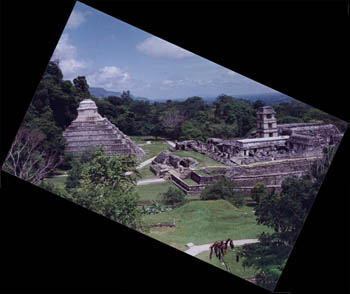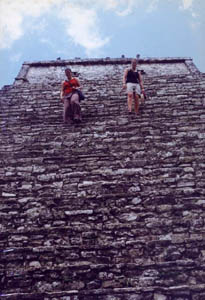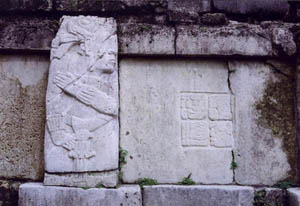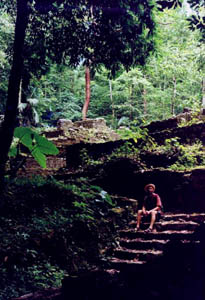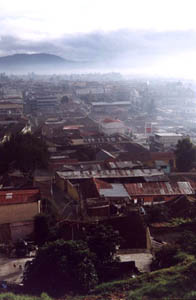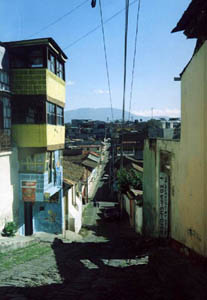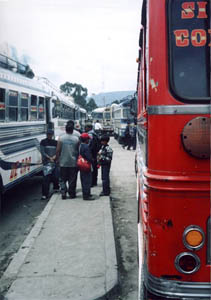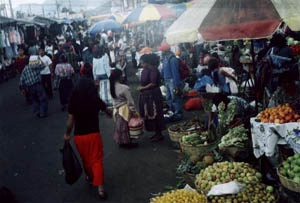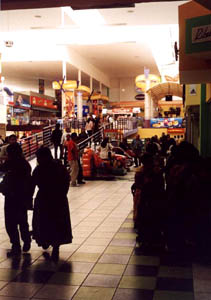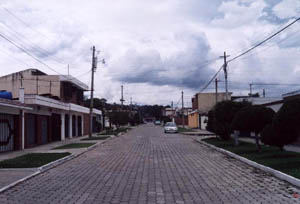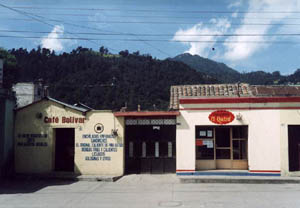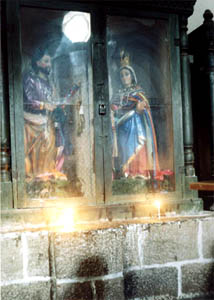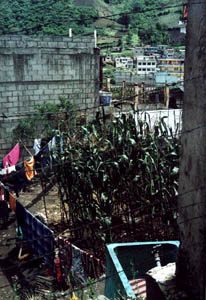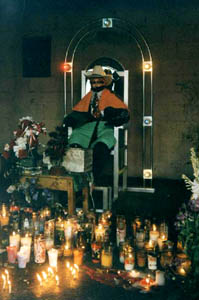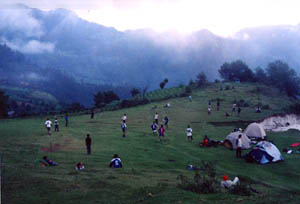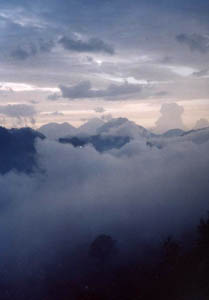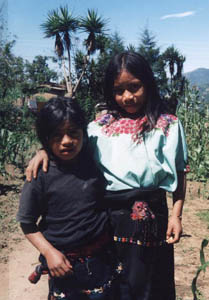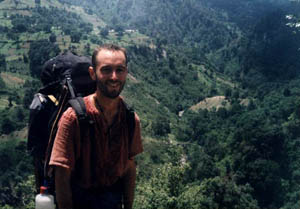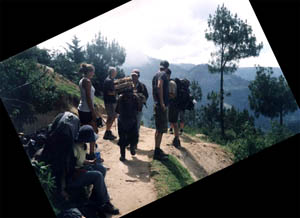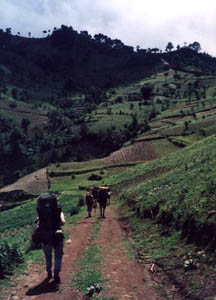| travel emails from Mexico & Guatemala, summer 2004 | ||||| quisquose.tripod.com ||||| |
| --- PAGE 1 --- --- PAGE 2--- |
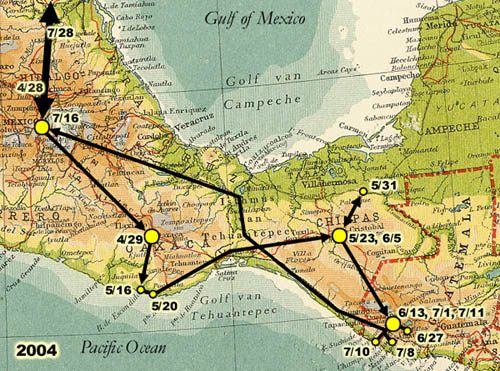
|
|
#01 arrival in Oaxaca
Sent: Thursday, 04/29/04 Hello friends and family! (sorry, this one´s pretty long, since it´s the first) I arrived in Oaxaca, Mexico yesterday after three weeks in New Jersey with my family and then three days back in Portland with Charla. I´ve seen a lot - mostly out of airplane and bus windows - the last week. My flight back to Portland was via Las Vegas, so after flying from the real New York skyline to the minature New York Casino skyline (I played a dollar in an airport slot machine. Lost.) I was treated to a gorgeous flight up the spine of the Cascade range, passing both Lake Tahoe AND Crater Lake, gorgeous. The Willamette Valley in Spring from an airplane is almost pornographic - it´s all just laid out there in all its exuberance and fertility. Charla and I spent some alone time together. I also fulfilled a minor goal and kayaked up the Willamette from Sellwood Park to the Steel Bridge and back (in retrospect, I highly recommend lots of sunscreen and stretches first!). Then it was back to the airplanes, this time with a stopover in Houston. Houston is such an intersting place, in part because, as I´m told, it has no zoning codes. The region certainly has no growth boundary. It´s beautiful - giant stands of trees in many places as you fly in - but suburban development EVERYWHERE in between (or rather, the blocks of trees are in between the development, kind of like how the trees seemed the minority against the giant clearcut blocks northeast of Crater Lake). Contrast this to my first clear sight of Mexico from the plane, after the clouds cleared: agricultural fields, everywhere, with small, distinct villages peppered here and there. Very green (this was the gulf coast, of course), but also very planned. I imagined it looked like what some parts of the Midwest must have looked like to the birds about a hundred years ago. Then the landscape changed. The rolling hills and small mountains northeast of Mexico City were just stunning from the plane - I´m looking forward to traveling in that area in the future. As we got closer to Mexico City I could see all the colors on the buildings, and the distinctive cathedrals and churches pointing out above the rest. Big, modernistic stadiums and institutional buildings in the larger cities --- big, but still part of hte city because they´re not surrounded by a sea of parking like in the States. I had expected a horrible giant sprawl of grey and dirt for Mexico City, for all the descriptions I´d heard of it. Instead, from the air at least, it looked quite interesting, even beautiful. Yes, it´s a megalopolis, 20 million people, I think. But it has trees. Lots of trees. And it seems have some distinct centers, multiple districts of skyscrapers and other buildings. In short, it looked like a city (an ENORMOUS city, to be sure), and not a nightmare sprawl like I´ve seen from the air of Detroit or other places. Of course, the city MUST feel contained, it´s ringed by mountains. I saw just a little of the Mexico City street from my taxi ride to the bus terminal, and the bus out of the city. I´m still adjusting to the physcial cues I see around me in this country; by that I mean, a long, dim concrete passageway at a dusty, crowded bus station can mean different things in different places. In Romania and some parts of the States, it means stay the hell out or be very vigilant. Here, I was almost shocked to see single women, old ladies, children, all ´middle class´ folks, walking through just such a place with no sense of fear or concern about them. Sort of like how when I first came to Portland in 1998, I was freaked out by the empty streets after dark. Empty streets where I had been living meant danger; in Portland (or that part, anyway) they were peacful. Culture shock comes in some weird forms. Anyway, I had a lovely bus ride down to Oaxaca, six hours, or two and three-quarter action movies. The buses of course are first-rate, quite comfortable, especially with earplugs. Gorgeous scenery, I learned the Spanish words for tree (el árbol) and fence (la cerca), and forgot the ones for cow and bridge. The shantytowns on the outskirts of towns and cities, and along the highway, are what they are, as are the stream beds and trenches that are the last home for unwanted plastic bags and bottles. (Well, what do you do when the municipality can´t afford to pick up garbage?). Now I´m in Oaxaca and getting familiar with my surroundings. It´s quite different from any town I´ve been in before, and I think it´s because it is a true colonial grid town. Buildings, mostly one-storey, as far as you can see down every street (which are all straight). No street trees or vegetation, except for the in zócalo (public square). It´s dusty and noisy, especially on the main streets. But it´s also full of life, people walking everywhere. The markets I´ve seen so far are amazing, full of everything (I´ve already tried my first - and last - fried grasshoppers) - and I haven´t even been to the REALLY big market out on the outskirts of town. As I was telling Charla on the phone a little bit ago, being here is already challenging me in many ways - the most prominent of which is my preoccupation with sticking out so much because of my skin color, and the discomfort I feel with that because of the history of European aggression, oppression and exploitation here (it´s not dissimilar from what I felt my first few weeks living in an overwhelmingly Black neighborhood in Brooklyn). I´m learning to get over it, realizing that most people don´t care - they´re here, I´m here, big deal. I´m starting with Spanish lessons next week, we´ll see what happens from there. I´ll try to get on email once or twice a week, and send something out to you all every other week or so. Take care, and have a wonderful May Day (I´ll have a great Cinco de Mayo, I know!). =) -d |
|
#02 three languages, one brain
Sent: Wednesday, 05/12/04 (approximately) Hello friends and family, I've now been in Mexico and Oaxaca for nearly two weeks, and am starting to get used to... well, the rhythm of life, I guess. Getting my obligatory bout of Montezuma's Revenge in the middle of last week was kind of a reset button - after a full day out of commission, I really felt like I was starting from scratch, physcially and mentally. Physcially things have been a bit of a challenge for me, mostly because of the heat. After a full Portland winter and three weeks of New Jersey spring, I'm suddenly in full sun and 90 degree heat with long pants (trying not to stand out more than I already do) any time I want to go anywhere. I understand more and more the reason for the siesta and big early-afternoon meal here. Mentally, school has definitely been challenging. The lessons are stimulating the "Foreign Language" portion of my brain, which is still trying to figure out how to partition itself. I reflexively want to say things in German and order things according to German grammar. Mostly amusing, but sometimes frustrating. The more I actually practice talking with people, though, the better this gets; although I'm still at the level where the only things I can say without thinking are "¡No entiendo!" (I don't understand), "¿Puedes repetir, por favor?" (Could you repeat that, please?) and "No quiero chapulinas, gracias." (I don't want any fried grasshoppers, thanks). I haven't been much of a tourist this last week. I visited some Zapotec ruins and the biggest (widest) tree in the world (15 m in diameter!) with some friends over the weekend, and have been to some of the local museums. I'm not quite ready to really dive in to the ridiculously huge markets here. The market near the 2nd class bus station is espeically overwhelming, taking up about ten square city blocks and offering everything you need and a lot more you don't, from clothes to stereoes to food to live turkeys. There seems to be some miracle of microeconomics here that allows twenty vendors all selling the same diverse inventory of hats/blouses/pants/belts/suitcases/grasshoppers to survive. Of course I've spent some time taking in the public life and public spaces of the city. Nearly every day that I've been there there's been some kind of demonstration or parade or march in the zócalo or the street, whether rural farmers with a flurry of soviet-style communist flags, or a local school celebrating its 70th anniversary, or an impromptu march against Mexico severing its relations with Cuba. The image of Che Guevarra is alive and well here, as is the image of the Zapatistas, even though I'm not even in Chiapas yet. The hostel I'm staying in is quite nice (thank you Jenn for the recommendation!), catering mostly to the 20- and 30-something backpacking crowd from Europe, the UK, the US, South America and Israel. It's not exactly like living with a Mexican family, but thanks to the loads of Mexican friends of the proprietors who come by, there is certainly no lack of opportunities to speak Spanish. I've met some interesting people, including a wacky Frenchman I spent a lot of time with last week, and have convinced with my glowing reviews of Portland to visit me next year. That's all for now. I'm finishing this first bit of clases this week, and then it's either south for some ocean and to meet up with friends (and hot and humid weather, I'm told), or east to Chiapas and the Mayan lands (and cool mountain weather, which sounds a lot more comfortable right now!). Take care, =) -d |
|
#03 a few days in paradise
Sent: Wednesday, 05/19/04 Hello family and friends, I finished up my two weeks of Spanish classes last Friday and, after probably a good eight hours in a bar with other students and my teachers for "Dia de los Maestros" (Day of the Teachers, which I never figured out if it's an actual holiday or not), decided to come down to the Pacific coast for a few days. It's absolutely gorgeous here, and the ride through the mountains (from 8,000 feet to sea level in five hours) and cloud forests was gorgeous as well; unfortunately the ride also included four hours of stomach-churning curves and turns, sitting cramped in the back bench of a van with three fellow western travelers. It was definitely one of my more uncomfortable traveling experiences, ranking up there with a historically intriguing Romanian overnight train I experienced seven years ago. We spent all day on the beach yesterday, and I got my first ever taste of tropical waters and bodysurfing - although now I've traded my churned stomach for a sunburned back (fortunately I found some aloe gel and avoided a night of agony). I'm currently traveling with three folks all about my age: Patrick, a jovial Swede who has traveled to 80 different countries and is on his way to Nicaragua to teach international relations; Shani, an Israeli woman fascinated by different cults and religions and is putting together ideas for a novel; and Mike, a lanky Texan who makes friends faster than anyone I've ever seen. I've met loads of other interesting people, including the Mexican musician brothers who ran the hostel in Oaxaca, my Mexican teachers at the school, and a woman from Chicago who is helping start a youth center in a remote village outside Oaxaca (she's invited me - and I'm seriously consdiering taking her up on this - to substitute teach her english classes there while she goes elsewhere in the month of July). Of course, I've been learning a whole lot about Mexican culture the last few weeks as well. I'm learning at the same time to not judge or jump to conclusions, so I'm just taking in what I see and hear - some of which is quite challenging to, especially, my sense of equal gender rights - and soaking up as much of these wonderful and sometimes bewildering people as I can. Machismo culture is alive and well, but at the same time, many young Mexicans I've met are riding the mixing flows of older traditional and newer western values. Like in so many other parts of the world these are decades of major cultural shift for the young generations, and the results can be both wonderful and horrible. (ok, I think I just made a judgement - oh well!) Well, time to put some more aloe on and stay the heck out of the sun. May is apparently the hottest time of year here, so the city is very bare - but the hard core surfers are still out, and backpackers keep trickling through. I might learn some sailing and scuba diving with Patrick the next few days before heading back inland - a great opportunity for me, and a great way to get out of the at times stifling heat. Much love to you all from hot-as-hell paradise, =) -d |
|
#04 dolphins, turtles, and horses
Sent: Thursday, 05/27/04 Hello family and friends, I left the coast and arrived here in San Cristóbal de las Casas, in the mountains of Chiapas, about four days ago. I finished up my days on the beach at the sleeply little coastal village of Mazunte, where I slept in a swinging bed on an outcropping overlooking the picture-perfect beach. It was still ridiculously hot, though, so I broke the heat by joining a 2-hour boatride to see dolphins and sea turtles; we saw both, as well as a pair of copulating sea turtles (which is less exciting than it sounds, as that species of sea turtle apparently takes up to 40 days floating in coitus to finish the job) and millions of tiny jellyfish. After an overnight bus ride, which I slept through handily thanks to my travel pillow and a little mezcal, I arrived here in San Cristóbal, my favorite place in Mexico so far. San Cristóbal is a medium-sized colonial town, surrounded by low mountains and filled with colorful, tile-roofed buildings that remind me, oddly enough, of Bulgaria. The city has the zocalo (plaza), cathedrals, neighborhood churches and markets like so many other Mexico cities - but there's something in the details here that really grabs me. Walking through San Cristóbal for me feels like reading through Italo Calvino's book, "Invisible Cities": - The sidewalks in San Cristóbal are all 12 to 24 inches above the street level, and are often hardly wide enough to fit two people - even of Mexican stature - abreast. Yesterday I found out the reason behind this design when it started raining. And raining. And hailing. And POURING. Not unlike a Portland rain squall, the show lasted for just an hour or so - but quite UNLIKE a Portland rain squall, the streets completely filled up with water. --- I was anxious to leave the tienda where I'd been eating, and dashed out towards my hostel halfway through the storm - whereupon I realized and appreciated the second foresighted design detail of San Cristóbal's streets, the eaves overhanging almost every sidewalk. I got two blocks staying relatively dry under the continuous eaves when I reached a downhill cross street... which unfortunately had been temporarily replaced by a river. As no boat came by after a few minutes, I eventually got a taxi to ford the water and make it home. --- I imagine a city that has designed its entire street system to occasionally serve as riverbeds, and its building eaves as umbrellas, has a culture that is also influenced by the rain - I'll find out if I stay here longer. - Speaking of streets, EVERY street in San Cristóbal that I've seen so far is covered in a hexagonal pattern, imprinted into the concrete. In an appropriately altered state of consciousness it probably looks like a beehive, or a giant Qbert game. Aliens or future archaeologists might think the citizens of this city worshipped wasps, or the sacred number six (as opposed to the sacred numbers 5, 7, or 2-and-seven-eigths). Or perhaps some property of the imprinted lines creates a flowform effect on rushing rainwater and is in part responsible for the sense of calmness in this city. (More likely it was just the cheapest way to make the concrete more slip-resistant for cars -- it's still pretty, though). - Life in the cities I've seen here so far seems to take place to some extent behind closed doors. There are no planting strips, or spaces between buildings - walking down a street all you see is walls and doors and the occasional window. --- Behind those doors, however, are courtyards, garages, inner buildings, stores, hotels, internet cafes (without coffee, go figure), workshops, factories... everything. Buildings housing services, like laundries, taquerias and the ubiquitous shoe store (there must ten shoes somewhere in Mexico for every man, woman and child in this country) keep their doors open, of course. But every once in a while you see a door open, or half open, that hides an old man surrounded floor-to-ceiling with machine tools, or a courtyard all painted in lime green, or a bare room with just a wooden table and a typewriter. Sometimes I feel like I'm walking through the Novels section of the bookstore, walking these streets. A few days ago I took a horseback riding trek up to the village of Chamula with some friends. Aside from the bone-jarring ride courtesy of my always-trotting horse, the trip was beautiful, snaking through pine forest and fields on the way up to this Mayan village. We only had an hour or so to spend in the village, but it was enough to visit the church - which alone was worth the bone-jarring ride. Apparently many people Mexico, especially indigenous people and especially rural indigenous people, are only nominally Catholic, mixing their religious activities with distinctly indigenous practices. In this church in Chamula, for example, the altar and sanctuary were lined with glass-encased porcelain and plastic statues of catholic saints, Jesuses and Marys, with John the Baptist holding the place of honor. Instead of pews, the floor was covered with pine needles, and in front of nearly every glass display case a space was cleared out for candles. I watched a number of Mayan families kneeling in front of different statues, the mother chanting in their own language. One family held a nervous-looking chicken, I was told perhaps for a sacrifice once the gringos cleared out. One thing I still can't get over, in every church I visit, is that the statues of saints and Jesuses and Marys are all of alabaster-white people. It's as inexplicable to me as the paintings of blue-eyed and blonde cartoon characters I see on just about every kindergarten building. I'm still taking things day-by-day, week-by-week. My current plan is to stay here in San Cristóbal for a few more days, doing conversation exchanges with Mexican students of English and taking in more of this city. Then I'll bus a few hours down the road to the Mayan ruins at Palenque - very fortunate timing, as I've heard that Palenque will be host to a Rainbow Family gathering next week (coinciding, I believe, with the Mayan Calendar Day Out of Time and its accompanying celebrations). After that, I'll probably spend some more time visiting the villages and jungle of Chiapas, leaving Guatemala and the Yucatan for the following weeks. All for now - much love from the beautiful highlands of Chiapas, =) -d |
|
|
#05 in to the jungle and back again
Sent: Tuesday, 06/08/04
Hello family and friends,
It so often happens when you travel like this that one day you have some
amazing experiences or thoughts/realizations, and then a few days later some
completely different experiences/thoughts/realizations, and after about a
week or to it all kind of blurs together like scoops of ice cream that have
melted into one big yummy soup (I haven't had any ice cream in a while).
Perhaps this is why time spent traveling to me seems to last three times as
long as, say, time spent pushing a mouse in front of a computer monitor.
My last week was definitely once such time. I wrapped up my week in San
Critobal (Chiapas) with a shopping spree at the artisans market (it's
amazing how many different variations there are on a blanket) and a visit to
a museum about the local Lacondon Maya, an indigenous group in the
rainforest who were never conqured by the Spanish. Then I made my way down
towards the Gulf coastal plan to the Mayan ruins of Palenque, said to be the
most extensive.
A word about the climate here - temperature in this part of the world is
very dependent on altitude. Back on the Pacific coast beach at Puerto
Escondido, and in Palenque, at probably only 80 meters above sea level, it's
HOT -- whereas here in San Cristobal (I came back), I wear a sweater and a
knit hat in the evenings. Not only do these climate changes play heck with
your wardrobe plans, they're often also not good for your health. I've run
into a number of other travelers who have climbed the 7,000 or so feet from
the coast to the mountian cities and needed a few days to feel back up to
speed again.
I haven't really gotten sick from altitude changes myself - instead, I've
been trading one mildly annoying physical condition for another this trip:
upset stomach in Oaxaca, sunburn in Puerto Escondido, runny nose in San
Cristobal (which I think was actually my body expelling all the salt water I
inhaled when trying to body board in Puerto), and then in Palenque...
mosquitoes and ticks! (fortunately, they do not have lyme disease or malaria
here).
Anyway, minor annoyances compared to the wonder of being among Mayan ruins,
choruses of cicadas, palm leaves bigger than me, monkeys, and tropical
waterfalls. I spent probably five days in Palenque, staying at a kind of
complex of posadas in the jungle just outside the ruins (a little like
Oregon Country Fair, almost). The ruins are spectacular, needless to say -
unlike many ruin sites, Palenque is not just a ceremonial center, but an
entire CITY (although only a fraction of it has been uncovered). My second
day I connected with some Rainbow family folks to trek out to the Gathering,
which required a beautiful 45 minute hike through jungle and fields (and
past a lovely jungle stream where I finally got to get out of the heat and
into the water for a bit) to the site: a rolling field just outside the
jungle with a giant tree as the center of operations.
The gathering was pretty small - only 75 or so - so I only stayed one night,
meeting a few people, helping with some chores, sharing the common meal and
singing krishna chants around the campfire until probably 3 in the morning
(not kidding about that last part - I do enjoy that kind of thing once in a
while). I didn't have a tent or hammock so I joined the rest of the
tent-less folks around the base of the tree - which was just fine except for
the ticks and mosquites, whose bites I started finding about a day later; oh
well, small price to pay. Woke up early and greeted the sun with the monkeys
and the birds as it rose over the forest and clouds - a gorgeous site.
Astute readers may have noticed that we were in a field just next to the
jungle - which means, of course, that we were in a clearcut that had
probably been turned from jungle to cow pasture just 15 or 20 years ago.
I've held the sadness of this, together with the awareness of the plight of
the landless poor here (to whom the government has been giving much of this
land to clear), together with the hope I get from seeing how (relatively
quickly) the jungle can grow back over the centuries: I've seen Mayan
temples in the jungle with giant trees growing out of them.
OK, on to the jungle, this email is getting long. A day or so later I went
walking on some of the trails I'd seen in the jungle on the way to the
gathering. I followed signs to the 'Templo Olvidado' ('Forgotten Temple'),
which turned out to be a small Mayan temple a good 20 minutes' walk into the
jungle, half uncovered and surrounded by trees, vines and palms (and not,
thankfully, by other tourists!). I was actually able to climb on top of the
structure completely, getting a gorgeous view that only the original masons
(and other climbers) would have seen. And after that temple, more trails,
more incredible trees, more uncovered and half uncovered Mayan buildings in
the jungle - there really IS a whole city back there. Amazing what you can
find when you just go off the beaten track a bit.
It was getting towards my time to start Spanish classes again, so I made my
way the next day or so back towards San Cristobal and Guatemala, stopping at
two waterfalls along the way. The 'Misol-Ha' cascade is 30 meters tall, you
can walk behind it all the way around to a cave that leads in to an
underground waterfall (and bats; I didn't stay long) - eminded me a lot of
Silver Falls, actually. The 'Agua Azul' cascade, next on the route, is
actually a kilometers-long series of smaller cascades, absolutely gorgeous
(especially when it hasn't rained the night before, which apparently turns
the waterfalls brown with silt thanks to - you guessed it - clearcuts
upriver).
By the time I made it to San Cristobal I decided to stay there (here) for a
week to do a Spanish course, and then go to Quetzaltenango in Guatemala to
do a second week ther (I couldn't decide between the two, so I chose both).
So now I'm on my second day of INTENSE Spanish courses plus homestay - my
brain hasn't felt this tired since I was learning German in Germany - but
it's good, and I'm learning a lot.
This is just a fraction of all I've been experiencing, but of course it's
not possible to write it all down. Now I've got to go for my 2:00 comida
(dinner) at my host house - I'll write more about that later. Best wishes to
you all, and take care,
=)
-d
|
|
|
#06 the road to Guatemala
Sent: Thursday, 06/17/04 Hello family and friends, I'm now in Quetzaltenango (also known by its Mayan name Xela, pronounced "Shay-la"), Guatemala; the classes here are even more intense than in Mexico - 5 hours a day, instead of 3 hours - so so far I haven´t done much but study and work with my teacher; but I've learned a lot - and not just about Spanish. First of all, I should wrap up my San Cristobal (Chiapas, Mexico) story. My homestay was uneventful - more like an expensive guesthouse - although I *did* learn some interesting things from the two other students at the house (a 50-something former firefighter from Spokane, WA, and a 20-something student from Montreal): namely that there's apparently a fairly large American expatriot community in San Miguel de Allende (news to me), and that it *is* true that no matter where in the world they are, Canadians will move hell and earth to catch that hockey game on TV (even when their team gets beaten by Tampa Bay. Ouch!). Anyway, I also took my first salsa lesson last week - and got to try it out the very next night when I went with some friends to the local reggae/salsa hangout. I learned something interesting here as well: when a Mexican tells you they "don´t really dance salsa", it may simply mean that they just don´t happen to teach it professionally. Suffice to say, I ended up spending two nights at this bar until 4am with a patient woman from Veracruz who tried valiantly to teach me the difference between Salsa, Cumbria, Merengue... Fairly hopeless (especially at that hour and after three hours of excellent reggae), although I did have a good time. One of those days also happened to be Corpus Christi day, which is celebrated in San Cristobal with a giant market of sweets (and I mean SWEET - even MY substantial sweet tooth was overwhelmed), there being some sort of legend about burros loaded up with sweets all converging on the city on that day. The sweets market, which took place for two days in the zocalo (town square) had to be squeezed in next to the encampment of students at a bilingual (Spanish-Mayan) teaching school who were protesting the government cutting their funds. Add to this the nightly live marimba band in the nearby bandstand, the weekly public salsa dance on the other side of the square, and the colorful assortment of shoe-shine guys, candy-seller boys, indigenous girls and old women selling their weavings (as well as keychains and dolls of little masked Zapatistas, complete with wooden gun), drummers, artists, and people watching the world go by, and you get a feel for what the culture and public life is like in this part of the world. So rich, so diverse, so alive! Anyway, on Sunday morning I finally set out for Guatemala. A three- hour ride on a comfortable Mexican bus brought me to the border town of Ciudad Cuahetemoc, from where I needed to take a taxi 4 km to the actual border. Now, lots of traffic comes from Guatemala into Mexico that the powers that be would rather not have, whether illegal immigrants, drugs or weapons - so I assumed the border crossing would be a fairly substantial bit of infrastructure - gates, military posts, outbuildings, etc. In reality, the "border" was little more than a pale-blue building on the side of a city street, which I wasn't even sure I needed to go into (no signs, go guards - in fact, I wasn't sure where the border "line" even was at all). The blue building had a couple teenagers (watching England v. Croatia in the EuroCup finals) to process my papers, and after 5 minutes I was back on the street to... to go where? No obvious taxi stand or bus station, just walk to what seems like a bus depot and ask. Well, it didn't take long to figure out that the painted-up school buses just up the road were in fact the legendary "Chicken Buses" that I'd heard about, and are the main way of getting around Guatemala. Soon enough, I was throwing my backpack up to the guy on the roof and squeezing with two other (Central American-size) adults into the seats designed for only two American schoolchildren. The ride was actually very enjoyable -- I liked being in a bus with color, music, decorations, and - best of all - open windows. I didn't mind being squeezed in either - it wasn't too hot (we're well over 2,000 meters above sea level here), and folks I've seen on this trip in this part of the world generally seem to be very relaxed and amiable. It ended up being a total of about 5 hours from the border to Xela, five hours full of gorgeous green hills and mountains, waterfalls, villages, and towards the end, the huge volcano outisde Xela looming in the distance. The landscape actually reminded me some of Oregon; the weather eventually has, too - even more so than Chiapas did. Bright sun and gorgeous clouds in the morning, rain and sun in the afternoon, never too hot, kind of cold in the evenings... I'm now on my fourth day in Xela, and while I haven't had much time to tour the city, or visit the hot springs and volcanoes outside the city, I've had some great conversations in Spanish with people here and am enjoying the immersion and focus on learning the language. I'll end for now, but there's so much more I want to write about what I've learned of Guatemala, the history here and the current situation - politics, war, religion, culture... I'm probably spending this weekend helping build cooking ovens in a nearby village (and possibly visiting another village where some indigenous rituals are still practiced), so I'll write about all that in the next email. Much love to you all, take care, =) -d |
|
#07 Colonialism now and then in Guatemala
Sent: Friday, 06/25/04 (approximately) Hello family and friends, I've been taking this second week in Quetzaltenango (aka "Xela"), Guatemala a little on the easy side. Last week's 5 hours per day spanish classes just about fried my brain. So this week I took some time to explore the city a bit, as well as a nearby village; I've also been taking a few guitar classes (my first ever!) in hopes of learning some Guatemalan and Mexican songs before I return to the States. I've also gone to a couple presentations my school offers: one on traditional Mayan medicine, and one of the state of education (and the struggles of the teachers´ unions) in Guatemala. More on some of those things below. The things I've been learning about Guatemalan society and culture have just been fascinating. Economics, religion, gender relations... just about every aspect of Guatemalan society seems to be in flux, and on top of that, inexoriably influenced by the US and Western Europe (for better and for worse). It's hard to split up these topics in a short email, so I'll throw them all together for a quick summary of my impressions. To start with, Guatemala has long had an uneven distribution of wealth and land. Things started to change in the 40s and 50s under a democratically-elected government that attempted to redistribute fallow land in a more equitable fashion. This upset many business interests, including those of the infamous United Fruit Company (US), and in 1954 the US administration intervened on United Fruit's behalf and had the CIA instigate its first government overthrow, leading to a succession of brutal military regimes (sound familiar?). To its credit, the US finally 'decertified' Guatemala in the 80s or 90s - but not before decades of terror and oppression, which led the disenfranchised to fight back with a guerilla war from the 60's until 1996. During the war (as well as after) government and rightist paramilitary forces massacred and tortured at will; the President during the early 80's, General Rios Montt, is widely considered to have pursued a policy of genocide against the indigenous Maya (who make up more than half the population, living in rural areas, villages, towns and cities). Although the war technically ended in 1996, isolated massacres have taken place since, and the ultra-right wing still controls the economy, military and government. Rios Montt even stood for re-election recently (he lost to a slightly less fanatical right-wing politician). So not only does the very recent memory of a brutal war, murdered friends, and terrorized communities hang over many, many people here, rule by the wealthy has made basic survival a problem for many as well. Even what you would expect to be the "middle class" - teachers, store owners, etc. - lives often hand-to-mouth. Society seems to hang together in large part thanks to the strong sense of family and community in this culture. Religion is a fascinating aspect of this whole situation. The majority of Guatemalans, I believe, are 'Latin Catholic' - Catholic in name, but ranging anywhere in practice from traditional European Catholic to mixing (and in some cases melding and morphing) Catholocism with indigenous rituals and beliefs. One extreme example of the latter is the altar of San Simon, which I visited today. San Simon seems to have his roots in a Mayan legend, but after the Spanish Conquest (or the Colonization, as it's sometimes referred to) in the mid-16th century, other stories said San Simon was a Spanish man, and even later he somehow came to be identified with Judas Iscariot, the apostle who betrayed Jesus. The town of Zunil is home to the statue of San Simon, which is moved to a different house every year for people to visit and venerate. I've already seen two processions here in Xela of religious statues being carried from one house to another (the statues are maintained and venerated by different 'Brotherhoods' - I have no idea how many there are). San Simon is a bit different, though. Whereas the stautes I saw in Xela looked like the kind of statue of Mary or Child-Jesus you'd see in any Catholic church, the statue of San Simon was, well, like this: - reclining in a chair that could be tilted back so offerings of rum can be poured into his open mouth (which supposedly disappears in his stomach, but apparently it's not uncommon for the husband of the house keeping San Simon to be an alcoholic by the end of his year of custodianship). - dressed in a two-piece black business suit, with white shirt and red tie. - wearing sunglasses and a hat, his open mouth covered by a black scarf, unless he is being given rum or a lit cigar. - sitting in a metal framework with three lights (red, white and blue) shining from the top. When I visited, a local family (indigneous - most of the villages seem to be mostly indigenous) was there, the father chanting in Quiche' while putting San Simon's hand on the heads of grandmother, wife, and two babies; a woman (in western clothes) on the statue's other side rubbed candles on San Simon's arm, I assume to bless them. (Oh, and you're charged 5 Quetzals (about 50 cents) to enter and Q$10 to take a photo.) Kind of an extreme example of the melding of religions, but the larger point is that despite colonization, religious practices will often persist, just in different forms. Think what you may about religious practices - indigenous, colonial or mixed - they are important CULTURAL practices for many, many people, binding people to their communities, and the older generations to the younger. It gets more complicated, however. Evangelicals, and recently, Mormons, have been converting people here in recent decades. Sometimes this has positive consequences - many people, and a number of entire villages, have kicked problems of alcoholism and poverty after turning Evangelical. It has negative consequences, however, as well - a number of Catholic Guatemalans I've spoken with have complained about how people going Evangelical has been tearing some communities apart. The Evangelicals have made a break from the existing Catholic-Indigenous culture; for indigenous families, I understand it also means renouncing their traditional ways, turning their backs on hundreds of thousands of years of inherited culture, forgetting their ancestors. A number of years ago, one village in Chiapas expelled around 200 families for turning Protestant (ie, for becoming a threat to the culture of the village) - these families now live impoverished on the outskirts of San Cristòbal. Of course, add to this the Evangelical stress on its 'way' being the ONLY way, and you can imagine the kind of complex (and for some, frightening) situation this creates, especially for a country fresh out of a civil war. I don't know much about the Mormon missionary work here, except that the city of Xela (around 100,000 I think) already has eight Mormon temples. (I've been told that Mormon religon holds that the Mayan ruins here were actually built by the lost tribe of Israel they believe Jesus appeared to in North America.) So on a day-to-day level, like I mentioned above, life for most people seems to be relatively challenging. One thing I didn't mention is social services, or the lack thereof. Guatemala has very little in the way of social services (thanks to decades of rule by the military and the rich) - one indication of this is the incredible amount of volunteer work happening right here in Xela. The local volunteer directory, www.entremundos.org, lists over 300 - many of which are constantly struggling to stay afloat. A friend here is working for a shelter/day care that may have to close if they can't raise the Q6,000 (about US$600) they need for the next year. Yet society contuines, and develops and grows - again for good (cooperatives flourish here, and many organziations pursuse sustainable development projects) and for ill (the new "Hiper Paiz" market just next to the main bus station is like a medium-sized US mall attached to a small big-box store, the latter of which sports signage and fancy advertisements in both Spanish and Quiche').... On the happier side of things, I've been thoroughly enjoying the Oregon-like clouds and sunsets, the exuberantly colorful buses, the slow time of siesta in the main zocalo, the company of new friends (many of whom are here for social justice work), and the friendly and warm- hearted Guatemalan people... I'm doing something a bit different this weekend and taking a 3-day trek with a local non-profit trekking outfit - we'll basically walk from Xela through mountains and villages to Lago Atitlan, apparently one of the most beautiful lakes in the world. For afterwards, I'm looking into finding a place where I can live with Guatemalan students, so I can immerse myself in Spanish for the next few weeks. OK, that's all for now. I'll probably write more from Lago Atitlan. Take care, and much love to you all... (and please drop me a note if you can and let me know how YOU'RE doing! I send out these emails but don't get many back!) =) -d |
|
|
#08 a few days in paradise, take two
Sent: Wednesday, 06/30/04 Hello family and friends, I'm now in San Pedro, Guatemala, on Lake Atitlan - and I feel like I've ascended into heaven and found paradise (I'll explain). I finished up my second week in Xela exploring the city, spending time with friends and attending a talk on current political events in Guatemala. Then on Saturday morning, I left with a trekking organzation (they're volunteer-run; proceeds are donated to a school for street children) on a three-day backpacking trek from Xela through the mountains and highland villages to here. It's hard to describe the utter beauty of the landscape here - dynamic rolling hills, mountains, gorges, and volcanoes; wind-swept grasslands; lush cloudforests; indigenous villages teeming with children and vibrant with the colors of traditional dress; acre after acre of small corn plots, coffee plots and bean plots; deep blue sky with layer after layer of clouds racing across, or rising majestically from the sunset. Of course, trekking (even a short run like this) is hard work - so there were also the steep switchback trails up the mountainsides, fully exposed to the midday sun; long, sweaty slogs through windless fields; and of course, blisters, sunburn and fatigue (luckily I came away with only one minor blister and deeply tanned forearms!). We were very fortunate to experience mostly clear skies - which meant no rain, and a spectacular sunrise over Lake Atitlan from our campsite on the rim. Lago Atitlan is said to be one of the most beautiful lakes in the world. It's a rain-fed lake in a volcanic crater, exactly like Crater Lake in Oregon - except about four times as big and surrounded by lush forest, vibrant lakeside villages and two or three dormant volcanoes. Spectacular - as evidenced by the lively tourist trade, and the number of gringoes who have made their home here (fortunately mostly concentrated in two of the nine or so towns here). San Pedro, where I'm staying, is known in backpackers' circles as the grittier but cheaper place to land and stick around for a few days. It's a good balance of backpacker infrastructure (cheap hostels, a couple gringo bars and restaurants, and some internet cafes) and real local life and culture. I like to stay in places like this once in a while so I can connect with other backpackers (and often run into friends I'd traveled with a few weeks ago - I've already run into six!) and, very importantly, get a decent cup of coffee (all the best coffee grown in this part of the world is either exported or sold to the gringo establishments that can afford it - everywhere else serves what amounts to dark sugared dishwater). I'm taking it easy here for a few days (splurging US$3.00 a night on a private room with toilet and shower) to relax from the trek and figure out the remainder of my trip. Oh, back to the trek. We were a group of 11, two guides (UK and US), four Americans, a Swede and four Israelis. Some scenes: - taking the "chicken bus" out of Xela down highway, then town street, then dirt road snaking through a village, then a dirt path through corn fields, with 80's pop music blaring the whole way. - seeing the smoke from Santiaguito Volcano as we started to ascend into the mountains. - bursting out of the winding, steep forest trail into the grasslands above, fast clouds and tiny villages in the distance, lunch in the shelter of a burnt-out tree. - walking a mountain ridge through cloud forest, passing the occasional indigenous man or kids carrying firewood, baskets, or a radio playing the EuroCup soccer finals. - reaching a campsite overlooking a whole curved valley of villages, gorgeous clouds coloring the sunset. - passing through corn fields and then villages, children running up to meet us and posing for photographs, parents smiling and laughing - bathing in a river at in a narrow sunny gorge, just above a tall waterfall - waking up on the overlook of Lake Atitlan in time for sunrise, watching the volcanoes emerge into sight, and the chimney smoke start to rise from the towns, wind sweeping patterns on the water. - the final hot, sunny, steep descent to the lake followed by a swim in the beautiful blue water, a boat ride to San Pedro and lunch overlooking the lake... We were TIRED after all that. Slept the afternoon, and spent the evening crowded into the town plaza for the 4-day festival that's happening right now. To top it all off, I went horseback riding with two friends to a different beach the next day, where we swam with a group of fifth-graders on a school beach trip (this horse ride was much better than the last - no trotting, only walking and galloping, which are much easier on the rear). I'm spending today writing an essay on "What is a nation?" for a scholarship 'contest', and looking up volunteer opportunities to see if I can stay here for a week instead of moving on to Guatemala City or back to Xela. No more spanish school for me - rather, I need practice, practice, practice. I figure I may as well do it here, where it's much cheaper than Xela and stunningly beautiful. Also, there are different things for me to learn about Guatemalan and village life here. San Pedro is so cheap because it's a farily poor region compared to Xela. Life is harder here, people live in worse conditions; I'm hoping to find some volunteer work where I can help with development/farming/eco issues while immersing in Spanish. Ok, enough for now. Much love to you all, =) -d |
|
| NEXT PAGE >> |
| top | home | updated 03/20/05 | ||||| quisquose.tripod.com ||||| |
